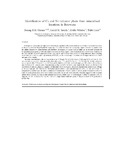| dc.contributor.author | Nkoane, B.B.M. | |
| dc.contributor.author | Sawula, G.M. | |
| dc.contributor.author | Wibetoe, G. | |
| dc.contributor.author | Lund, W. | |
| dc.date.accessioned | 2010-06-25T10:24:01Z | |
| dc.date.available | 2010-06-25T10:24:01Z | |
| dc.date.issued | 2005 | |
| dc.identifier.citation | Nkoane, B.B.M. et al (2005) Identification of Cu and Ni indicator plants from mineralised locations in Botswana, Journal of Geochemical Exploration, Vol. 86, pp. 130–142 | en_US |
| dc.identifier.issn | 0375-6742 | |
| dc.identifier.uri | http://hdl.handle.net/10311/527 | |
| dc.description.abstract | Plant species that accumulate high levels of metals in proportion to the metal content in the soil are of considerable interest
in biogeochemical and biogeobotanical prospecting. This study was aimed at investigating copper and nickel accumulation in
the plants Helichrysum candolleanum and Blepharis diversispina, to assess their potential use as mineral indicators in
biogeochemical prospecting. Soils and plants were collected from copper–nickel mineralised areas in Botswana. Analyses of
the soils and the respective plant parts (roots, stem, leaves and flowers) were carried out using ultrasonic slurry sampling
electrothermal atomic absorption spectrometry (ETAAS), which allowed rapid determination of copper and nickel in small
amounts of the samples.
The metal concentration in the soil was in the range c40 Ag/g–4% (w/w) for Cu and c60 Ag/g–0.3% (w/w) for Ni. The
concentration ranges of the elements in the plant parts were c6 Ag/g–0.2% Cu and c3–210 Ag/g Ni. At high soil metal
content (greater than 2.5% (w/w) Cu and 0.1% (w/w) Ni), high levels of both nickel and copper were found in the shoots (leaves
and flowers) of H. candolleanum. Concentrations as high as 0.2% (w/w) Cu were found in the leaves and flowers of H.
candolleanum, indicating hyperaccumulation for this plant. For B. diversispina, the metal concentrations did not exceed 100 Ag/
g for any plant part, for both metals. Both plant species tolerate high concentrations of metals and should therefore be
categorized as metallophytes. In order to evaluate metal translocation from the soil to the shoots, metal leaf transfer coefficients
(ratio of metal concentration in the leaf to metal concentration in the soil) were calculated. Our data suggest that the two plant
species have different metal uptake and transport mechanisms, which needs to be investigated further. The present work also
suggests that H. candolleanum may be used as a copper/nickel indicator plant in biogeochemical or biogeobotanical
prospecting. | en_US |
| dc.language.iso | en | en_US |
| dc.publisher | Elsevier www.elsevier.com/locate/jgeoexp | en_US |
| dc.subject | Helichrysum candolleanum | en_US |
| dc.subject | Blepharis diversispina | en_US |
| dc.subject | Copper | en_US |
| dc.subject | Nickel | en_US |
| dc.subject | Indicator plants | en_US |
| dc.subject | Metallophytes | en_US |
| dc.title | Identification of Cu and Ni indicator plants from mineralised locations in Botswana | en_US |
| dc.type | Published Article | en_US |

